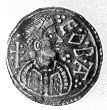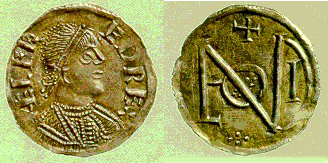Coinage
 Coins were not struck by the continental Angles and Saxons, and save for the errant Roman coin it is unlikely that any coins were used by the early settlers in their new homeland. The first coins employed by the Anglo-Saxons were the gold solidus (about 4 grams) and smaller tremisses from Meringovian Gaul, brought over to England between 550 and 650 AD. A number of these gorgeous coins ended up being used as decorative pendants and thus were not truly in circulation. King Penda of Mercia struck gold coins, circa 650 AD, but generally speaking silver sceattas, and not gold coins, were the standard Anglo-Saxon issue.
Coins were not struck by the continental Angles and Saxons, and save for the errant Roman coin it is unlikely that any coins were used by the early settlers in their new homeland. The first coins employed by the Anglo-Saxons were the gold solidus (about 4 grams) and smaller tremisses from Meringovian Gaul, brought over to England between 550 and 650 AD. A number of these gorgeous coins ended up being used as decorative pendants and thus were not truly in circulation. King Penda of Mercia struck gold coins, circa 650 AD, but generally speaking silver sceattas, and not gold coins, were the standard Anglo-Saxon issue.
From the time King Offa of Mercia took over the Canterbury mint in 785, silver pennies of such compelling design were minted with his name and likeness, and also with the likeness of his wife, Cynethryth, that they were copied by continental mints – a first, for usually the Franks set the tone in everything stylistic.
Offa introduced pennies; unlike the sceattas which were pellets hammered between two dies, pennies were struck from blank discs. Pennies bore portrait heads, and a distinct reverse bearing the name of the moneyer. It is difficult to know what exactly a penny was worth; the scholar James Campbell suggests it may have been roughly equal to a day’s work. (A pound was of course, literally a pound of silver, equaling 240 new unworn pennies.) Because silver pennies were too valuable to be used much in everyday trade – coins were mostly used by professional merchants; ordinary folk relied upon bartering goods and services – Ælfred the Great (871-99) introduced the half-penny. To help in their adoption, coins were oftentimes minted with a cross scoring the obverse, so that they could be fairly divided into halfs and quarters.

A penny of Ælfred’s. The reverse spells out “London”, where the coin was struck..
With the partitioning of England into the Danelaw during the 880’s, the Danes of East Anglia began striking their own pennies upon the model established by Ælfred. Many of these Danish-minted coins even bear Ælfred’s name, but they are clumsy imitations and under-weight as well. The Vikings of York did better. Their coins were often of original design, sometimes combining Christian and heathen motifs, such as representations of St. Peter with a Thor’s hammer.
Foreign coins collected at English seaports from returning merchants were re-minted on the spot, assuring the creation and continuation of mints at Canterbury and London. Obviously the making of money could only be entrusted to persons of undisputed integrity, and severe penalties were imposed upon moneyers caught debasing the coinage of the realm. In Athelstans’ reign (924-39) there were eight mints in London, seven in Canterbury, and six in Winchester; by 1066 there were over 20 in London and 12 in York.
Coins were of course subject to all sorts of abuse, from rasping off bits of silver from the edges to complete recasting with admixtures of base metals. By the end of Edgar’s reign (959-75) a truly standardized design for the penny was created, with dies supplied from one mint. The design of the coins was changed at fixed intervals, at first from six, and then three years; coins in circulation were to be turned in and re-minted in the new design.
